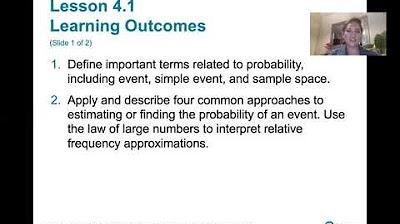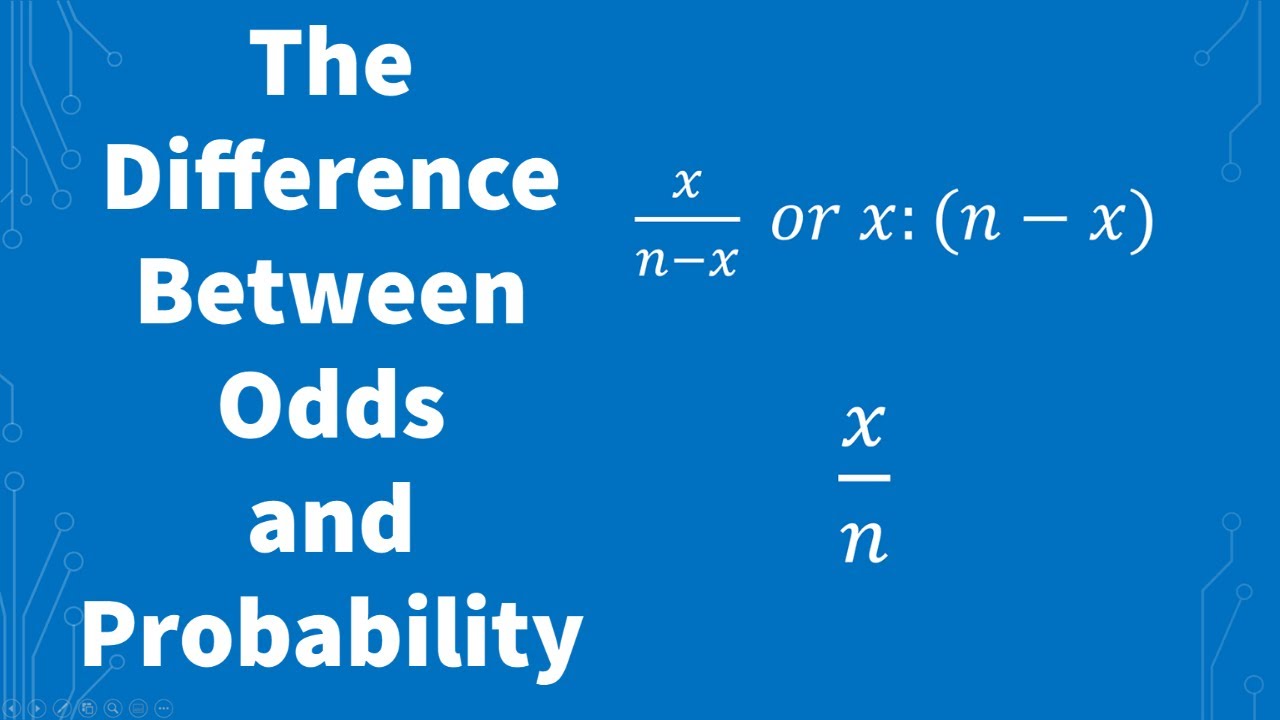4.1.5 Basics of Probability - Odds and Their Relation to Probability
TLDRThis video lesson delves into the concept of odds and their relationship with probabilities, both crucial for understanding likelihoods. It explains how odds, often used in gambling contexts like casinos and lotteries, are more complex to calculate than probabilities, which are frequently used in research and social sciences. The instructor clarifies the difference between 'odds for' and 'odds against' an event, and introduces 'payoff odds', illustrating these concepts with a roulette example. By calculating the probability of winning and the associated odds, viewers learn how to interpret these numerical expressions and their implications in gambling scenarios.
Takeaways
- 📊 Both odds and probabilities are measures of likelihood but are used in different contexts.
- 🎰 Odds are often used in gambling scenarios such as casinos, lotteries, and race tracks to facilitate money transfers.
- 🧐 Understanding odds is essential for those who engage in gambling activities to know what the numbers represent.
- 🤔 Probabilities are easier to compute and are commonly used in research and social sciences.
- 📐 Actual odds against an event are calculated by the ratio of the probability it doesn't happen to the probability it does.
- 🔄 The actual odds in favor of an event are the reciprocal of the odds against, flipping the ratio.
- 💰 Payoff odds are different from likelihood expressions; they represent the ratio of net profit to the amount bet.
- 🎯 In gambling, understanding the difference between actual odds and payoff odds is crucial for knowing potential winnings.
- 🔢 The example of roulette illustrates how to calculate probability, actual odds, and payoff odds for a bet on odd numbers.
- 📉 The probability of winning in roulette is less than half due to the presence of zero slots, making it approximately 47%.
- 🏆 The script emphasizes the importance of intuitively understanding and verifying calculated probabilities to avoid errors.
Q & A
What is the main topic discussed in the video?
-The video discusses learning outcome number five from lesson 4.1, which focuses on odds and their relation to probabilities.
How are odds different from probabilities?
-Odds are generally more difficult to compute than probabilities and are often used in contexts like gambling where money transfers are involved. Probabilities are easier to compute and are widely used by mathematicians and statisticians.
Why are odds commonly used in gambling contexts?
-Odds are used in gambling contexts because they make it easier to deal with money transfers associated with bets.
What are the actual odds against an event occurring?
-The actual odds against an event 'A' occurring are given by the ratio of the probability that 'A' does not happen to the probability that 'A' does happen.
How do you simplify the odds ratio?
-If the odds ratio is, for example, 16 to 4, you simplify it by dividing both numbers by their greatest common divisor, resulting in a simplified ratio of 4 to 1.
What are payoff odds, and how do they differ from odds in favor or against an event?
-Payoff odds are not expressions of likelihood but are ratios used by casinos to represent the net profit to the amount bet. They differ from odds in favor or against an event, which are measures of likelihood.
What is the probability of winning when betting on an odd number in roulette, considering the provided example?
-The probability of winning when betting on an odd number in roulette, given the example, is 18 out of 38, which simplifies to approximately 0.4737 or 47%.
How do you find the actual odds in favor of winning?
-To find the actual odds in favor of winning, you take the probability of winning divided by the probability of not winning. In the example, this would be 18/38 divided by 20/38, simplifying to 9/10.
What would be the payoff if the payoff odds were 2 to 1 and you made a $20 bet?
-If the payoff odds were 2 to 1 and you made a $20 bet, the net profit would be $40, meaning you would receive $60 back, including your original $20 bet.
What is the significance of understanding odds in daily life, particularly for those living in areas with casinos?
-Understanding odds is significant in daily life, especially for those living in areas with casinos, as it helps them comprehend the likelihood of winning and the potential outcomes of their bets, aiding in better decision-making when gambling.
Outlines
🎲 Understanding Odds and Probabilities
This video covers learning outcome number five from lesson 4.1, focusing on odds and their relationship to probabilities. It explains that both odds and probabilities measure likelihood but differ in complexity and usage. Odds, often used in gambling contexts, are harder to compute than probabilities. The lesson details odds against an event, odds in favor of an event, and payoff odds. It emphasizes understanding these concepts, especially for those in areas with prevalent gambling activities like casinos.
🔢 Calculating Probabilities with a Roulette Example
The video provides an example using a roulette wheel to illustrate probability calculations. With 38 possible outcomes (including zero and double zero), it explains how to determine the probability of landing on an odd number. The calculation involves dividing the 18 odd numbers by the 38 total outcomes, resulting in approximately a 47% chance of winning. This example demonstrates the practical application of probability concepts and the importance of intuitive understanding.
📊 Odds in Favor and Against Winning
Continuing with the roulette example, the video explains how to find the actual odds in favor of winning by dividing the probability of winning by the probability of not winning. Using the same example, it shows that the odds in favor of winning are 9 to 10. It also discusses the odds against winning, which is the reciprocal, 10 to 9. The explanation reinforces the relationship between odds in favor and odds against an event.
💰 Understanding Payoff Odds
This segment focuses on payoff odds, which differ from likelihood expressions. Payoff odds represent the ratio of net profit to the amount bet. Using different payoff odds scenarios (1:1 and 2:1), the video calculates potential net profits from a $20 bet. It further explores a hypothetical situation where payoff odds match actual odds against winning, resulting in a net profit calculation of approximately $22.22. The discussion clarifies the concept of payoff odds and their practical implications in gambling.
🧮 Summarizing Odds and Payoff Odds
The final part of the video recaps key points about odds and payoff odds. It distinguishes between the probability-based odds for and against an event and the ratio-based payoff odds. The explanation covers the formulae for calculating these odds, emphasizing the importance of understanding these concepts for making informed decisions in gambling and other contexts where odds are used.
Mindmap
Keywords
💡Odds
💡Probabilities
💡Payoff Odds
💡Likelihood
💡Classical Approach
💡Numerator
💡Denominator
💡Net Profit
💡Gambling
💡Roulette Wheel
Highlights
Learning outcome number five from lesson 4.1 covers odds and their relation to probabilities.
Odds are more difficult to compute than probabilities and are used in different contexts.
Odds are often used in gambling because they make money transfers easier.
The lesson covers odds against something happening, odds in favor of something happening, and payoff odds.
Understanding odds is important when engaging in activities like going to a casino or playing the lottery.
Probability is another expression of likelihood that is relatively easy to compute and widely used in research and statistics.
Actual odds against an event occurring are given by the ratio of the probability that the event does not happen to the probability that it does happen.
The formula for actual odds in favor of an event occurring is the reciprocal of the formula for the odds against it.
Payoff odds are used by casinos to describe the ratio of net profit to the amount bet.
The probability of winning an odd number bet on a roulette wheel is calculated by dividing the number of odd numbers by the total number of possible outcomes.
The actual odds in favor of winning are found by dividing the probability of winning by the probability of not winning.
The actual odds against winning are the reciprocal of the odds in favor of winning.
Payoff odds describe the potential profit relative to the amount bet and are different from odds that express likelihood.
If the payoff odds are 1 to 1, betting $20 and winning would result in a net profit of $20.
If the payoff odds are 2 to 1, betting $20 and winning would result in a net profit of $40.
Transcripts
Browse More Related Video

4.1.0 Basics of Probability - Lesson Overview, Key Concepts and Learning Outcomes

Case-Control Study and Odds Ratio | Statistics Tutorial #31| MarinStatsLectures

Relative Risk vs Odds Ratio! EXTENSIVE VIDEO!

Medical Statistics - Part 4: Calculating Odds

What Is The Difference Between Odds and Probability? | Statistics

Risk, Rate and Odds
5.0 / 5 (0 votes)
Thanks for rating: